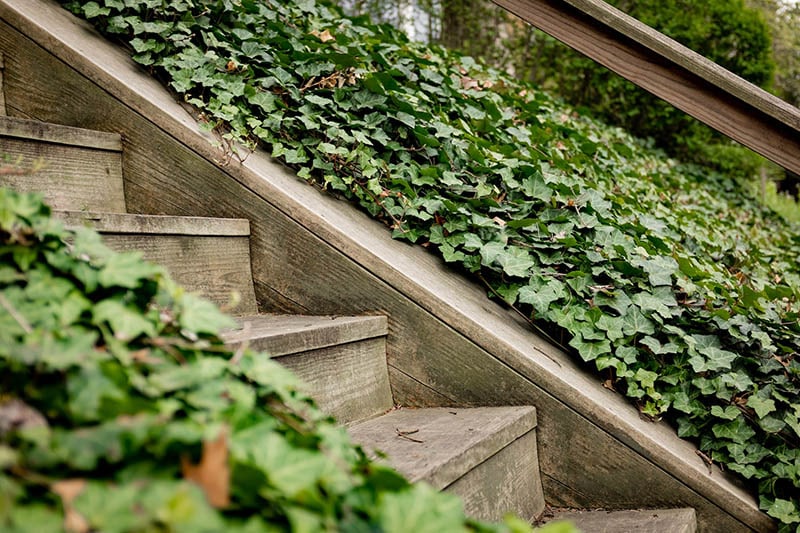What Are Witches Stairs? Pros, Cons & Types
-
Codee Chessher
- Last updated:

An unusual home design choice made waves as users on social media rediscovered that it was dubbed “witches’ stairs.” These steep, alternating stairways are allegedly witchproof, but in reality, they’re mostly used as a space-saving choice. Let’s check out how witches’ stairs work, where they’re used, and some other relevant info you might find interesting.
What Are Witches Stairs & How Do They Work?
Witches stairs, also known as alternating tread stairs, are used in some situations. The stairs feature wide, alternating half treads that require you to climb them in a particular order. The half-treads allow the steps to be steeper than regular stairs without being too difficult to climb. Witches’ stairs are typically used in New England homes to access lofts or attics.
In recent years, the stairs became popular on social media, with some users claiming the stairs were initially used in New England homes. The urban legend goes that witches can’t climb the steps. In reality, they’re used in place of ladders or perilous circular staircases to reach secluded rooms.
Regular stairs require more space than witches’ stairs, and homes with small footprints might be unable to spare the space. The tradeoff is that you’ll have to ascend or descend the stairs more carefully, and building codes typically require witches’ stairs to have handrails installed because of their steep height.
Witches’ stairs are also used to save costs because alternating half treads are cheaper to produce and install than standard stairs. In turn, you’ll have more floor space in the rest of the home and can save money. For small homes and apartments, witches’ stairs prevent you from losing valuable floor space for stairways you rarely use.
Lastly, witches stairs can be found in various colors and styles to match any home decor. Wood can match rustic cottages or metal can be used in a sleek, modern home.
The 3 Other Types of Stairs
Witches’ stairs are aesthetically interesting and a novel concept, but they’re far from the only stairs. We’re all most familiar with the straight stairway, the L-shaped stairway, and perhaps the circular staircase. Let’s check those out below in further detail.
1. Straight Stairs

Straight stairs are some of the most common, and for good reason. They’re relatively cheap to build and only need fastening at the top and bottom. It is also very easy to install rails for straight stairs, though they may only need them if they exceed a certain height or number of steps. The biggest downside of straight stairs is that they eat up a lot of linear space in your floor plan.
2. Spiral Staircase

Spiral stairs are very striking, with a tight, helical design that saves space on your floor plan. They’re also pretty easy to install, but they can’t be used as the only stairway for second-floor access. As far as practicality goes, spiral stairways are a hard sell. They’re hard to carry objects on, narrower, and don’t accommodate many people simultaneously.
3. L-Shaped Stairs

L-shaped stairs have a central landing between flights, allowing you to rest between steps. They can also serve as a privacy barrier between areas, and putting the stairs between walls can muffle noise between floors. The main issue with this stair design is that it’s challenging to build, requiring more support than other stairs.
Where Are Witches Stairs Used?
As mentioned above, witches’ stairs are most commonly used in small homes or as a space-saving measure for larger homes. Building codes usually forbid alternating treads as main stairways, reserving them as accessways for rarely used rooms like attics.
If you hate the idea of climbing a ladder to access your attic or loft, witches’ stairs are a perfect alternative. Witches’ stairs also reduce home construction costs compared to straight stairways.
Advantages of Witches Stairs
Witches’ stairs have a few advantages that make them worth using over other stair designs. Let’s go into more detail about their pros below.
Saves Space
Witches’ stairs have deeper half-treads than the full treads on other stairways, which allows more depth per tread. As a result, the stairway uses less linear space to go up to higher levels in the home. For small apartments and homes, this increases livable space that you can add to other areas.
Improved Comfort & Safety
It takes practice to master ascending and descending witches’ stairs because you must use a particular pattern of steps. With regular stairs, on the other hand, you can climb with either foot in any pattern. However, once you learn how to climb witches’ stairs, you’ll find that the higher half-treads are very comfortable. It also helps that witches’ stairs always have handrails!
Cost-Effective
Witches stairs require less material to create and install than regular stairs, so they’re also cheaper to have installed. For homes on a budget, alternating tread stairs can be an attractive and cheap way to access an attic or mezzanine.
Disadvantages of Witches Stairs
Witches stairs save space and look neat, but they have some significant drawbacks that you should know about before you commit to them for your home. Let’s see what these drawbacks are and why you might not want witches’ stairs in your home.
They Have Building Restrictions
Witches’ stairs might be more popular, but local building codes may have various restrictions on where to use them. Here are the restrictions localities may have in place for witches’ stairs.
- Can’t be used as the main stairway in the home
- May only lead to one room, like the attic, basement, or mezzanine
- Alternating steps must be fitted with a safety rail
Not Suitable for Children
Witches’ stairs are typically steeper than regular stairs, which kids may struggle with. They probably won’t have the coordination and balance required to ascend and descend witches’ stairs safely. If you have kids, witches’ stairs are strongly discouraged for safety reasons.
Requires Practice
It takes time to get used to the unusual step pattern required by witches’ stairs, and practicing how to climb stairs isn’t on most people’s to-do lists. It may add a layer of discomfort while you get used to how to climb the stairs safely.
Frequently Asked Questions
Were witches’ stairs really used to ward off witches?
It almost sounds plausible because of the Salem witch trials, but alternating tread stairs did not deter witches from entering homes. There are no mentions in historical literature¹ of these stairs being used to ward off witches. The nickname likely came later due to the stairs being more common in New England and their unique look.
How much cheaper are witches’ stairs than regular stairs?
It’s impossible to give an accurate quote, but you can expect to save hundreds of dollars going with alternating witches’ stairs over a regular stairway. Other factors that impact the cost include the size of the stairway and the chosen material.
Are witches’ stairs right for me?
If you have children, we wouldn’t recommend witches stairs because they’re unsafe. But if you live alone or have no kids in the home, they can be a great secondary stairway to access an attic or basement. They’ll save you floor space in your home and cost less, but you’ll need to learn how to walk up and down them. If you don’t mind the tradeoff, witches stairs might be the right choice for your home.
In Conclusion
Witches stairs have an unusual appearance and name, but they’re mainly a space and cost saver in homes. They’re not recommended for homes with children since they’re difficult to climb. However, for homes without children, they’re an excellent option for saving space and construction costs. They can’t be the main stairway, but they’re a great alternative over ladders for attics and lofts.
Featured Image Credit: Joshua Olsen, Unsplash
Contents


